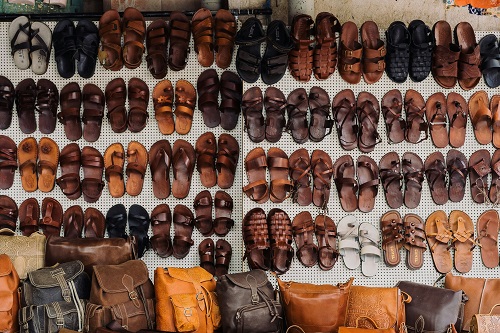Handcrafted Leather Sandals Case Study

Iwear Ke, a distinguished brand of handcrafted leather sandals, originated from the founder’s passion for traditional craftsmanship and a keen eye for footwear trends. The owner identified a gap in the market for high-quality, artisanal leather sandals that blend comfort with style, inspiring the inception of IWEAR KE is intricately guided by a commitment to providing individuals with a penchant for unique and handmade footwear with a curated collection that reflects their appreciation for craftsmanship.
The owner’s dedication to sourcing premium materials and collaborating with skilled artisans ensures the brand’s alignment with the preferences of its target audience. The decision to establish an online presence was a strategic move, allowing IWEAR KE to transcend geographical boundaries and showcase its exquisite leather sandals to a global audience. This digital platform serves as a convenient hub for customers to explore and purchase meticulously crafted footwear.
Running the business successfully demands a skilled team comprising experienced craftsmen, designers, customer service professionals, and efficient supply chain management. The labor-intensive process of handcrafting each pair of sandals underscores the brand’s commitment to quality and attention to detail.
IWEAR KE employs various marketing techniques, including visually appealing social media campaigns, collaborations with fashion influencers, and an engaging website showcasing the artisanal process.
Limited edition releases, exclusive online promotions, and consumer testimonials contribute to the brand’s authenticity and customer trust. The effectiveness of these strategies is monitored through sales analytics and customer feedback, ensuring IWEAR KE continues to thrive in the competitive market of handcrafted leather sandals.
Step-by-Step Guide to Running Your Handcrafted Leather Sandals Business
Step 1: Vision and Branding
Articulate the unique selling points and aesthetic values that will set your brand apart. Craft a distinct brand identity to guide all your future decisions. Journal your thoughts on what inspires you about hand-crafted leather sandals. Create a vision board with images and concepts that resonate with your style. This exercise will help crystallize your brands ethos.
Step 2: Market Research
Thorough market research is crucial. Analyze trends, identify competitors, and understand your target audience. This will inform your design choices, pricing strategy, and marketing approach. You want your leather sandals to resonate with a specific niche within the market. Use Google Trends to identify rising trends in handmade footwear. Explore social media platforms like Instagram and Pinterest to analyze popular styles and customer preferences. Check online marketplaces such as Etsy and Amazon for customer reviews on existing handmade leather sandal brands.
Step 3: Product Development
Collaborate with skilled artisans to create prototype designs. Quality is paramount, so carefully select the finest leather materials. Seek feedback from potential customers and make adjustments to ensure your products meet both style and comfort expectations. Hire a graphic designer on platforms like Fiverr or Upwork to create a unique logo. Source eco-friendly packaging options from suppliers on Alibaba or Uline. Test different packaging designs with a small group of potential customers to gather preferences.
Step 4: Branding Materials
Invest in professional branding materials, including a memorable logo, packaging that reflects your brands identity, and tags that convey the craftsmanship behind each pair of sandals. Sketch your initial design concepts on paper or use digital tools like Adobe Illustrator or Procreate. Attend local craft fairs or fashion events to gather inspiration from other artisans and designers. Create a focus group with friends or potential customers to get feedback on your design concepts.
Step 5: Online Presence
Establish a user-friendly e-commerce website showcasing your handcrafted leather sandals. Prioritize high-quality images, detailed product descriptions, and a secure checkout process. Utilize social media platforms as key tools for building a community around your brand. Use website builders like Shopify or WordPress to create an e-commerce site. Leverage Instagram and Facebook Ads for targeted advertising to reach potential customers. Collaborate with influencers in the handmade or fashion niche to promote your brand.
Step 6: Manufacturing and Inventory Management
Establish relationships with reliable suppliers and manufacturers. Implement efficient inventory management systems to prevent overstock or shortages, ensuring a smooth production and fulfillment process. Research leather suppliers on platforms like Alibaba or ThomasNet. Attend industry trade shows or conferences to connect with material suppliers in person. Request samples from potential suppliers to assess the quality of their materials firsthand.
Step 7: Marketing and Promotion
Leverage various marketing channels such as social media campaigns, influencer collaborations, and promotions to generate buzz. Engage in storytelling about the craftsmanship behind each pair of sandals as a central theme in your marketing strategy. Implement email marketing using platforms like Mailchimp or Constant Contact. Create a visually appealing content posting schedule across platforms.
Step 8: Scaling and Diversification
As your business grows, explore opportunities for scaling production and potentially diversifying the product line. This may involve introducing new designs, expanding into related accessories, or exploring collaborations. Hire artisans through platforms like LinkedIn or local craft communities and set up regular team meetings to foster communication and collaboration in the workshop.
Step 9: Continuous Improvement
Regularly gather customer feedback and stay attuned to market trends. Continuously refine both your product and overall business strategy. Adaptability is key to long-term success. Set up a feedback form on your website using Google Forms or Typeform. Monitor reviews and comments on social media and address customer concerns promptly. Analyze sales data and customer feedback to make informed decisions about improvements.
Estimated Start-up Costs
Vision and Branding:
Cost for developing a unique brand identity, including logo design and branding materials: Kshs. 5,000 to Kshs. 20,000.
Market Research:
Cost for market research tools and resources: Kshs. 2,000 to Kshs. 5,000.
Product Development:
Cost for collaborating with artisans to create prototype designs and sourcing high-quality leather materials: varies widely depending on the scale and complexity of designs.
Branding Materials:
Cost for professional branding materials such as logos, packaging, and tags: Kshs. 5,000 to Kshs. 15,000.
Online Presence:
Cost for establishing an e-commerce website and social media presence: varies depending on platform and customization needs.
Website development: Kshs. 10,000 to Kshs. 30,000.
Social media advertising budget: Kshs. 5,000 to Kshs. 15,000.
Manufacturing and Inventory Management:
Cost for establishing relationships with suppliers and managing inventory: varies depending on the scale of production and sourcing methods.
Marketing and Promotion:
Cost for marketing materials, campaigns, and promotions: Kshs. 5,000 to Kshs. 20,000.
Scaling and Diversification:
Cost for expanding production capacity, introducing new designs, or diversifying product line: varies depending on growth strategy and business needs.
Continuous Improvement:
Cost for gathering customer feedback, monitoring market trends, and making improvements: ongoing and may vary depending on specific initiatives.
Totaling these estimates, the startup costs for a handcrafted leather sandal business in Kenya could range from approximately Kshs. 32,000 to Kshs. 120,000, excluding expenses related to product development and manufacturing, which can vary significantly based on the scale and complexity of operations. Actual costs may vary based on specific business plans, location, and other factors.

